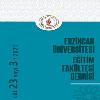Öğrencilerin Yabancı Dil Sınıflarında Karşılaştıkları Kültürlerarası Kavramları Öğrenme Becerilerinin Geliştirilmesi
Kültürlerarası kavramlar, kültürel engeller, kültürlerarası farkındalık
Enhancing Students' Ability to Comprehend Intercultural Concepts in EFL Classes
Intercultural communicative competence, intercultural language learning, prospective English teachers,
___
- Alptekin, C. (2002). Towards intercultural communicative competence in ELT. ELT Journal, 56(1), 57-64. Atay, D., Kurt, G., Çamlıbel, Z., Ersin, P., & Kaslıoğlu, Ö. (2009). The role of intercultural competence in foreign language teaching. İnönü University Journal of the Faculty of Education, 10(3), 123-135. Atay, D. (2005). Reflections on the Cultural Dimension of Language Teaching. Language and Intercultural Communication, 5(3-4), 222-236. Aydemir, E., & Mede, E. (2014). Integrating Target Culture in EFL Classrooms. Turkish Online Journal of Qualitative Inquiry, 5(1), 20-33. Bachman, L. (1990). Fundamental considerations in language testing. Oxford: Oxford University Press. Bada, E. (2000). Culture in ELT. Çukurova Üniversitesi Sosyal Bilimler Enstitüsü Dergisi, 6(6), 100-110. Brown, D. (1994). Teaching by principles. An interactive approach to language pedagogy. USA: Prentice Hall. Byram, M. (1997). Teaching and assessing intercultural communicative competence. Clevedon: Multilingual Matters. Byram, M. (2006). Language teaching for intercultural citizenship: The European situation. Paper presented at the NZALT conference, University of Auckland. Celce-Murcia, M. (1995). A pedagogically motivated model with content specifications, Issues in Applied Linguistics. 6, 5-35. Damen, L. (1997). Culture learning: the fifth dimension in the language classroom. USA: Addison-Wesley. Dörnyei, Z. (2007). Research methods in applied linguistics: Quantitative, qualitative and mixed methodologies. Oxford: Oxford University Press. Genc, B., & Bada, E. (2005). Culture in language learning and teaching. The Reading Matrix, 5(1), 73-81. Gonen, S., & Saglam, S. (2012). Teaching Culture in the FL Classroom: Teachers’ perspectives. International Journal of Global Education, 1(3), 26-46. Hyde, M. (1998). Intercultural competence in English language education. Modern English Teacher, 7(2), 7. Hymes, Dell H. (1972). “On communicative competence”. In Pride, J.B.; Holmes, J. Sociolinguistics: selected readings. Irving, K. (1986). Communicating in context. New Jersey: Prentice Hall Regents. Kahraman, A. (2016). Teachers’ and Learners’ Attitudes towards Culture and Culture Learning in a Turkish Context. Journal of Language and Linguistic Studies, 12(2), 1-12. Kiet Ho, S.T (2009) Addressing culture in EFL classrooms: The challenge of shifting from a traditional to an intercultural stance. Electronic Journal of Foreign Language Teaching, 6(1) 63-76. Kramsch, C. (2003). Context and culture in language teaching. Oxford: Oxford University Press. Kramsch, C. & Sullivan P. (1996). Appropriate pedagogy. ELT Journal, 50(3), 199-212. Liddicoat, A.J., Papademetre, L., Scarino, A., & Kohler, M. (2003). Report on intercultural language learning. Canberra ACT: Commonwealth of Australia. Önalan, O. (2005). EFL Teachers' Perceptions of the Place of Culture in ELT: A Survey Study at Four Universities in Ankara/Turkey. Journal of Language and Linguistic Studies, 1(2), 215-235. Sarıçoban, A., & Çalışkan, G. (2011). The influence of target culture on language learners. Journal of Language and Linguistic Studies, 7(1), 7-17. Seelye, H. (1993). Teaching culture: Strategies for intercultural communication. NTC: Lincolnwood, Illinois. Sarigul, E. and Ashton-Hay, S. (2005) Culture and English Language Teaching: Raising Awareness. In Proceedings 9th International INGED (Turkish English Education Association) Conference "New Horizons in ELT", Economics and Technical University, Ankara Turkey. Sharifian, F. (2011). Cultural conceptualisations and language: Theoretical framework and applications (Vol. 1). John Benjamins Publishing. Singhal, M. (1998). Teaching culture in the foreign language classroom. Thai TESOL Bulletin, 11(1). Stern, H. (1992). Issues and options in language teaching. Oxford: Oxford University Press Tomalin, B., & Stempleski, S. (1993). Cultural awareness. Oxford: Oxford University Press. Tuna, Ö. K. & Razı, S. (2016). Integrating Culture into ELT Classes: What, Why, and How?. Procedia-Social and Behavioral Sciences, 232, 41-48. Yeşil, Ş., & Demiröz, H. (2017). An Exploration of English Language Teachers' Perceptions of Culture Teaching and Its Effects on Students' Motivation. International Journal of Progressive Education, 13(1), 79-95.
- Yayın Aralığı: Yılda 4 Sayı
- Başlangıç: 1999
- Yayıncı: Erzincan Binali Yıldırım Üniversitesi
Hayat Bilgisi Dersinde Estetik Değerinin Kazandırılmasına İlişkin Sınıf Öğretmenlerinin Görüşleri
Soner ALADAĞ, M Pınar KUZGUN, Gürkan KUŞCUOĞLU
The Structural Composition of The Projective Competence
Mehmet ÖZBAŞ, Dinara MUKHATAYEVA, Aigulim AITBAYEVA, Gulmira KASSEN
Osmanlı’dan Cumhuriyet’e Hoşgörü: 7. Sınıf Öğrencilerinin Farkındalıkları Üzerine Bir Değerlendirme
Ortaokul Öğrencilerinin Problem Alanlarının Belirlenmesi (Bursa Örneği)
Mehmet Akif ERDENER, Fahri SEZER, Erdoğan TEZCİ
Türkçenin Zenginliği ve Ana Dili Bilincinin Ortaokullarda Kazandırılması: 5. Sınıf Örneği
Ortaokul Öğrencilerinin Problem Alanlarının Belirlenmesi
Mehmet Akif ERDENER, Fahri SEZER, Erdoğan TEZCİ
Öğretmen Adaylarının Uzaktan Eğitime Yönelik Tutumlarının Bazı Değişkenler Açısından İncelenmesi
Kürşat YENİLMEZ, M Zafer BALBAĞ, Melih TURGUT
Görsel Sanatlar Öğretmeni Adaylarının Görsel Okuryazarlık Düzeylerinin Belirlenmesi
Cinsiyetin Sosyal Bağlılık Üzerindeki Etkisi: Bir Meta-Analiz
